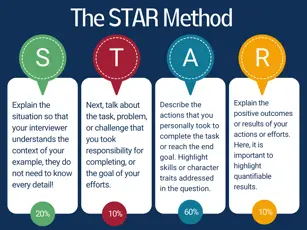6 Steps to Write a Resume
A resume follows certain rules, and writing it is not challenging when you know the standard format. For fresh graduates or those with less than 2 years of work experience, the resume should not exceed one page of A4 paper.
In this blog post, Aniday will cover the six steps to writing a resume that will catch the attention of your interviewers.
1. Name and Contact Information

At the top of the resume, write your name and contact information. Contact information usually includes your phone number, email, and address. It's better not to include overseas phone numbers.
Many HR professionals may only pass your resume if they see the correct contact information or an overseas number. No matter how impressive your resume is, if they can't reach you, it's all in vain. Make sure HR can find you.
2. Resume Photo
It's important to remember that the requirements for a resume may vary depending on the country you're applying for a job in. Therefore, it's crucial to check the norms and guidelines of your targeted country before creating your resume.
The correct location for the photo is the upper right corner of the resume. When choosing a photo, it's recommended to use a formal ID or professional photo with a smile. Do not use selfies or casual photos, as they appear less formal.
Photo size: 1-2 inches for ID photos.
3. Educational Background
For job seekers with little work experience, educational background is the most important, so it should be listed at the beginning. In most countries, HR professionals pay close attention to your educational background, especially for fresh graduates. You must clearly state your university, major, GPA, major courses, and the duration of your studies.
Start with your highest degree, and if you have a master's degree, list it first, followed by your bachelor's degree.
If you have limited educational experience or attended a less well-known school, it's advisable to mention your major courses. When listing major courses, be sure to mention those directly relevant to the job you are applying for. For example, if you are applying for a marketing position, you can list marketing-related courses.
4. Internship Experience/Project Experience

Your resume must include an internship or project experience, as HR professionals attach great importance to this. This is particularly crucial for fresh graduates because they lack work experience. Internship experience can help HR professionals assess your job skills and career plans.
If you don't have internship experience, you can list project experiences, such as team projects or thesis topics from school. This section should occupy more than half of your resume. Key information such as company and school names should be bolded, and the experiences should be listed in reverse chronological order.
For the hiring company, your most recent internship or project experience is what they focus on. When writing the specific internship content, ensure that it's accurate and aligns closely with the job description.
For instance, many international students have worked as campus ambassadors for certain companies, helping to expand the student market. This experience is relevant when applying for marketing positions.
But what if you're applying for a data analysis role? You can describe how you conducted student market research, used Salesforce (or other CRM software) to record and analyze student data, and helped the department develop marketing strategies tailored to your school.
5. Campus Experience
International students can also list the activities they participated in and the clubs they joined at school. For example, if you served as a department head in the student union, write about your responsibilities and achievements. Through your campus experiences, recruiters can determine whether you are actively engaged in activities and whether you have leadership qualities or potential leadership qualities.
6. Honors/Awards/Skills
Finally, in your resume, you can list any awards or honors you received in school or mention your skills, such as certifications, language abilities, or computer skills. For example, if you are applying for an accounting position and have a CPA or CFA certificate, or if you're applying for a translation position and have translation certification, include these details in your resume.
How to Write a Concise Resume

alt text: how to use the STAR method
As mentioned earlier, internship or project experiences should occupy more than half of your resume, but that doesn't mean that the more you write, the better it is. After all, a resume has limited space, so the content must be concise and focus on the essentials. When writing your resume, you can use the STAR method, which can be summarized as Verb + Work Content + Method + Result.
STAR stands for:
-
Situation: Describe the context or situation.
-
Task: Explain the task or objective.
-
Action: Describe the specific actions taken.
-
Result: Explain the outcomes or results.
The STAR method should include comparisons between the past and the present. By emphasizing the main points in your experience descriptions, HR professionals can quickly find the information they need and understand what you are talking about. HR professionals review many resumes daily.
If you use the STAR method to write your content, your resume will have a significant impact. The STAR method in practice:
-
Market Intern:
-
As a marketing intern, I mainly promoted our product in the market.
-
In three months, I successfully introduced our product to students in 11 cities.
-
On average, more than 1,000 students at each university used our product.
-
I covered universities through methods such as emails, WeChat, Weibo, university advertising, and online event promotions.
-
Through this internship, I gained deep insights and experience in market development, event promotion, channel expansion, and time management.
-
Resume Tips
Finally, here are some resume tips for you to refer to as you craft your resume!
-
Keep the resume within one page; don't write too much.
-
Avoid overly elaborate formatting; the most critical part of the resume is the text, and unnecessary graphics should be omitted.
-
Don't allocate most of the space for self-summaries, awards, and activities.
-
Highlight key experiences; prioritize and organize content effectively.
-
Ensure there are no obvious format or grammatical errors in the resume.
-
When sending an electronic version of your resume to HR, make sure it's in PDF format to avoid formatting issues.
In Summary
All in all, resume writing is not as difficult as you might think. As long as the resume is clean and concise, highlighting your work abilities and strengths, you can easily create an impressive resume that catches the eye of HR professionals.
Aniday hopes that the above six steps are simple and informative for you to follow to craft your perfect resume.
Aniday's HR Services
Headhunting Service
Find and recruit quality candidates in just 1 week! Supported by 40,000 experienced headhunters in IT, Finance, Marketing… capable of recruiting in any region.
Headhunting Service ➔Employer of Record (EOR) Service
On behalf of your business, we recruit employees and handle payroll without the need to establish a company in markets such as Vietnam, Singapore, Malaysia, India, Indonesia…
Employer of Record (EOR) Service ➔